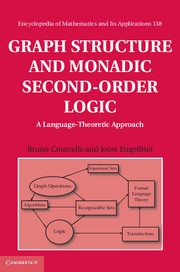Book contents
- Frontmatter
- Contents
- Foreword
- Introduction
- 1 Overview
- 2 Graph algebras and widths of graphs
- 3 Equational and recognizable sets in many-sorted algebras
- 4 Equational and recognizable sets of graphs
- 5 Monadic second-order logic
- 6 Algorithmic applications
- 7 Monadic second-order transductions
- 8 Transductions of terms and words
- 9 Relational structures
- Conclusion and open problems
- References
- Index of notation
- Index
Introduction
Published online by Cambridge University Press: 05 July 2012
- Frontmatter
- Contents
- Foreword
- Introduction
- 1 Overview
- 2 Graph algebras and widths of graphs
- 3 Equational and recognizable sets in many-sorted algebras
- 4 Equational and recognizable sets of graphs
- 5 Monadic second-order logic
- 6 Algorithmic applications
- 7 Monadic second-order transductions
- 8 Transductions of terms and words
- 9 Relational structures
- Conclusion and open problems
- References
- Index of notation
- Index
Summary
This book contributes to several fields of Fundamental Computer Science. It extends to finite graphs several central concepts and results of Formal Language Theory and it establishes their relationship to results about Fixed-Parameter Tractability. These developments and results have applications in Structural Graph Theory. They make an essential use of logic for expressing graph problems in a formal way and for specifying graph classes and graph transformations. We will start by giving the historical background to these contributions.
Formal Language Theory
This theory has been developed with different motivations. Linguistics and compilation have been among the first ones, around 1960. In view of the applications to these fields, different types of grammars, automata and transducers have been defined to specify formal languages, i.e., sets of words, and transformations of words called transductions, in finitary ways. The formalization of the semantics of sequential and parallel programming languages, that uses respectively program schemes and traces, the modeling of biological development and yet other applications have motivated the study of new objects, in particular of sets of terms. These objects and their specifying devices have since been investigated from a mathematical point of view, independently of immediate applications. However, all these investigations have been guided by three main types of questions: comparison of descriptive power, closure properties (with effective constructions in case of positive answers) and decidability problems.
A context-free grammar generates words, hence specifies a formal language. However, each generated word has a derivation tree that represents its structure relative to the considered grammar.
- Type
- Chapter
- Information
- Graph Structure and Monadic Second-Order LogicA Language-Theoretic Approach, pp. 1 - 15Publisher: Cambridge University PressPrint publication year: 2012

